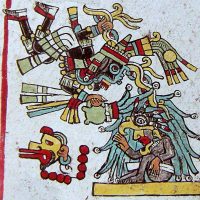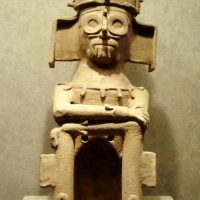Dzahui : Rain God of the Mixtecs
Listen
At a glance
| Description | |
|---|---|
| Origin | Mixtec Mythology |
| Classification | Gods |
| Family Members | N/A |
| Region | Mexico |
| Associated With | Rain |
Dzahui
Introduction
Dzahui is the powerful rain deity of the Mixtec civilization, one of the most influential cultures of ancient Mesoamerica. For the Mixtecs—who called themselves Ñuu Savi, meaning “People of the Rain”—Dzahui represented life, nourishment, and the delicate balance of nature upon which their survival depended. His presence appears across Mixtec codices, sacred narratives, and archaeological remains, emphasizing his role as both a benevolent provider and a deity whose displeasure could unleash calamity.
The Mixtec world, centered in the regions of present-day Oaxaca, Puebla, and Guerrero, flourished for centuries through intricate artistic traditions, agricultural innovation, and a deeply rooted spiritual framework. Within this framework, Dzahui stood at the apex as a god whose blessings dictated the success of the agricultural cycle. From the earliest Mixtec manuscripts, such as the Codex Vindobonensis and Codex Zouche-Nuttall, Dzahui emerges as a divine authority whose domain shaped the destiny of an entire people. His mythology, rituals, and iconography together highlight the profound reliance of ancient Mixtecs on rain-fed agriculture and the spiritual reverence that grew from this dependence.
Physical Traits
Depictions of Dzahui in Mixtec codices present a deity whose features symbolize his command over rain, storms, and fertility. He is frequently illustrated wearing a distinctive blue or green rain-goggle mask, a visual cue that associates him with water and aligns him with the broader Mesoamerican rain-god imagery seen in deities like Tlaloc of central Mexico. These goggle-eyes, often large and circular, evoke the lenses of divine perception through which he watches over the skies and fields.
Dzahui’s mouth is typically rendered with exposed incisors and elongated jaguar-like canine teeth, curling outward in a fierce expression. This fusion of human and jaguar traits emphasizes his ability to bring both life and destruction—rain that nourishes, and storms that devastate. In several representations, especially in jadeite carvings, Dzahui appears with a curved lip and pronounced teeth, reinforcing his connection to earlier Tlaloc imagery while retaining uniquely Mixtec stylistic elements.
A recurring detail in his codex portrayals is a blue or green protrusion emerging from his nose, interpreted as a symbol of rain, storm breath, or divine essence. Through these visual elements, Mixtec artisans conveyed Dzahui’s authority as a weather deity whose powers shaped the fate of their farmland and communities.
Family
Direct genealogical relationships for Dzahui are not extensively documented in Mixtec codices, which often emphasize symbolic roles over detailed familial lineage. Instead, Dzahui is situated within a cosmological system where deities are interconnected through their domains rather than explicit family trees. His position aligns him with other elemental and agricultural powers responsible for shaping the natural world.
Within broader Mesoamerican cosmology, Dzahui is often discussed alongside creator forces and elemental beings who structured the cosmos. He shares conceptual space with deities who governed earth, maize, and growth—figures whose responsibilities depended on the rains he provided. Ritual traditions reveal that Mixtec priests invoked Dzahui in conjunction with regional rain gods such as Cocijo of the Zapotecs and Tlaloc of the Aztecs, highlighting a shared spiritual understanding across cultures that depended on seasonal rainfall for survival.
While his family ties may be ambiguous, Dzahui’s presence within the pantheon reflects an essential divine role: he is the rain-bringer who enabled agriculture, shaped ecological rhythms, and maintained harmony between the people and their land.
Other names
Dzahui appears in several linguistic variations across the Mixtec cultural region. The name Dzavui is a common alternate spelling, reflecting differences in dialects and historical transliteration practices. Despite these variations, the meaning and significance of the deity remain consistent, anchoring him firmly within Mixtec spiritual identity.
The ethnonym Ñuu Savi, “People of the Rain,” directly references Dzahui’s importance and highlights how deeply he is embedded in Mixtec cultural consciousness. In comparative contexts, Dzahui is often paralleled with other Mesoamerican rain gods—particularly Tlaloc—due to similar iconography and ritual practices. However, Dzahui remains distinctly Mixtec in character, mythology, and cultural memory, embodying a regional expression of the rain god archetype that permeates Mesoamerican belief systems.
Powers and Abilities
Dzahui’s greatest power is his control over rain, the crucial element that governed the agricultural cycle and ensured community survival. As the divine orchestrator of seasonal rainfall, he determined whether crops would flourish, whether rivers would swell, and whether the land could sustain its people. His ability to bring life-giving water positioned him as a benevolent guardian, yet his absence could unleash drought, famine, and disease.
Historical accounts and Mixtec codices indicate that rituals conducted in Dzahui’s honor were elaborate and vital to community life. Ceremonies were often performed on hilltops, symbolizing closeness to the heavens from which the rains descended. During severe droughts, particularly in pre-Hispanic times, child sacrifices were offered to Dzahui—a practice consistent with Mesoamerican rain cults, including those dedicated to Tlaloc. These acts were believed to restore balance and appease the deity, ensuring renewed rainfall.
Dzahui’s influence extended beyond rain alone. As a fertility deity, he contributed to agricultural abundance, ecological stability, and the overall prosperity of Mixtec society. His protective and punitive powers reinforced the importance of maintaining ritual reciprocity between humans and the divine environment.
Modern Day Influence
Although the direct worship of Dzahui diminished following Spanish colonization, his legacy endures within contemporary Mixtec identity and cultural revitalization efforts. The Mixtec people still identify as Ñuu Savi, honoring their ancestral bond with the rain and the natural world. Dzahui’s imagery survives in codices, museum collections, academic studies, and artistic reinterpretations that celebrate Indigenous heritage.
Modern scholars view Dzahui as a vital figure for understanding ecological relationships in ancient Mesoamerica and the sophisticated spiritual frameworks that connected people to their environment. Indigenous communities in Oaxaca and neighboring regions are increasingly reclaiming their pre-Hispanic traditions, often highlighting Dzahui as a symbol of resilience, environmental reverence, and cultural continuity.
Today, Dzahui stands not only as an ancient rain god but also as a powerful emblem of Mixtec identity—reminding future generations of the enduring bond between humanity, myth, and the natural world.
Related Images
Source
Mixtecs. (2022, April 7). In Wikipedia. Retrieved November 13, 2025, from https://en.wikipedia.org/wiki/Mixtec_culture
Dzahui. (2021, January 31). In Wikipedia. Retrieved November 13, 2025, from https://en.wikipedia.org/wiki/Dzahui
Mixtec Mythology. (n.d.). Folklore Earth. Retrieved November 13, 2025, from https://folklore.earth/mixtec-mythology/
Mixtec Mythology: Origin, History, Gods, Myths +32 Facts. (2023, October 31). Mythology.guru. Retrieved November 13, 2025, from https://mythology.guru/mixtec-mythology/
Zapotec & Mixtec Mythology Gods and Creatures. (n.d.). Mythlok. Retrieved November 13, 2025, from https://mythlok.com/zapotec-and-mixtec-mythology/
Mixtec Standing Figure of Dzavui (Tlaloc). (2020, June 1). Vilcek Foundation. Retrieved November 13, 2025, from https://vilcek.org/news/mixtec-standing-figure-dzavui/
Opening of the exhibition Mixtecs Ñuu Dzahui. (2018, January 11). Cultura Gob. México. Retrieved November 13, 2025, from https://cultura.gob.mx/exhibition-mixtecs-nuu-dzahui
The Country of the God of the Rain. (n.d.). World In Words. Retrieved November 13, 2025, from https://world-in-words.com/country-god-rain
Terraciano, K. (2001). The Mixtecs of Colonial Oaxaca: Ñudzahui History, Sixteenth Through Eighteenth Centuries. Stanford University Press.
Boone, E. H. (2000). Stories in Red and Black: Pictorial Histories of the Aztecs and Mixtecs. University of Texas Press.
Jansen, M., & Pérez Jiménez, L. A. (2007). Codex Zouche-Nuttall: A Pre-Columbian Painted Manuscript from Mexico. British Museum Press.
Caso, A. (1963). Kings and Lords of the Mixteca. University of Oklahoma Press.
López Austin, A. (1997). The Human Body and Ideology: Concepts of the Ancient Nahuas. University of Utah Press.
Frequently Asked Questions
Who is Dzahui in Mixtec mythology?
Dzahui is the Mixtec god of rain, fertility, and agriculture, central to the survival and spiritual practices of the Ñuu Savi people.
How is Dzahui depicted in Mixtec codices?
He is shown with blue or green rain goggles, jaguar-like fangs, exposed teeth, and sometimes a nasal protrusion symbolizing rain.
Is Dzahui the same as Tlaloc?
While he shares visual similarities with Tlaloc, Dzahui is a distinct Mixtec deity with unique cultural significance.
What rituals were performed for Dzahui?
The Mixtecs held hilltop ceremonies and, in severe droughts, carried out child sacrifices to appease the rain god and restore balance.
How is Dzahui remembered today?
Dzahui remains a cultural symbol among Mixtec communities and appears in modern art, scholarship, and indigenous revitalization movements.









